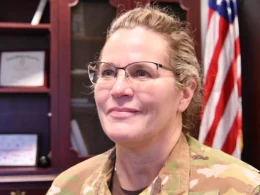JOINT BASE SAN ANTONIO-LACKLAND, Texas – The Air Force Security Forces Center is launching a shared corrections facilities concept aimed at improving operations and filling gaps in confinement operations across the Department of the Air Force.
AFSFC, in partnership with installation leadership, the Air Force Installation and Mission Support Center’s Installation Support Directorate and the Air Force Civil Engineer Center, is set to establish a “hubbing” concept that includes realigning existing corrections noncommissioned officer billets across all major commands, closing three corrections facilities and building five new ones.
The concept follows Air Force Program Action Directive 12-06 that outlined the need for efficiencies in confinement and corrections to include reducing the burden on installations to operate and upkeep confinement facilities. In addition to using sister-service confinement facilities, the PAD provided for the use of civilian confinement facilities to ensure installation leaders had access to appropriate confinement facilities within a four-hour driving distance.
Although many of the actions undertaken as part of the PAD were implemented successfully, the AFSFC team found gaps in civilian confinement operations.
“Lapses in supervision of confines, substandard practices and other violations caused Air Force leadership to look for alternative incarceration options,” said Edward Outlaw, director of Air Force Confinement and Corrections at the AFSFC.
The PAD also “lacked earmarked funds to fully accomplish a hubbing concept,” said Mark Vivians, AFIMSC’s Installation Development Branch chief.
To remedy these issues, Outlaw championed a funding approach to and, in late 2018, AFIMSC’s Strategic Enterprise Integration Board issued a first-of-its-kind Special Enterprise Execution Direction Memorandum to financially support the confinement facilities initiative.
“Of the 62 continental United States and Alaska bases, only 25 have the organic capability to incarcerate,” Outlaw said. “Being able to fully implement hubbing operations means we’ll give each Air Force base the capability to incarcerate on the installation or use an adjacent base’s shared facility.”
“It’s been a team effort for sure with all sides handling their respective areas of expertise,” Outlaw added. “Working with (AFIMSC counterparts) and the installations has been quite fruitful, and we all rely on each other to get the mission to move forward. It’s true what they say: teamwork makes the dream work.”
The five new hub facilities are planned for Joint Base McGuire-Dix-Lakehurst, New Jersey; Sheppard AFB, Texas; Travis AFB, California; Joint Base Elmendorf-Richardson, Alaska; and Hill AFB, Utah.
The first, at JBMDL, broke ground Nov. 28.
Facilities slated for closure are at Eglin AFB, Florida; Vandenberg AFB, California; and Shaw AFB, South Carolina. Those bases all have correction facilities available within their local hubs.
“By streamlining operations and maximizing resources, the Air Force can optimize staffing, training and infrastructure resources while delivering more consistent and efficient correctional services,” Vivians said.









